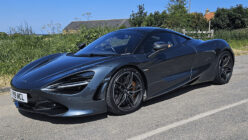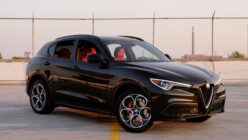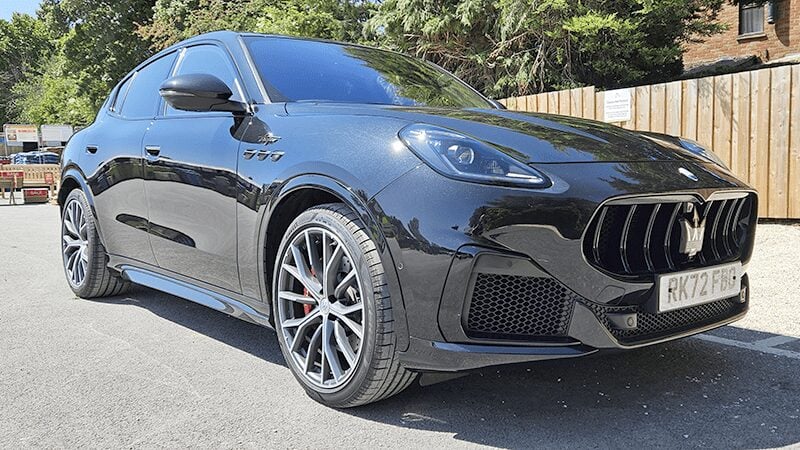
The Grecale is probably the most important Maserati on sale, representing the entry point to trident ownership. Starting at a little over £60,000 it’s the least costly car in the range and is, of course, a family-friendly crossover SUV; if you want to capture sales from other brands, you need one of these in your offerings.
It’s closely related to Alfa Romeo’s Stelvio, though there’s a lot to differentiate the two models (and the third, related Stellantis car, which is Jeep’s Grand Cherokee) – aside from being the same size, you really wouldn’t notice without some of the details being pointed out. However both do offer a halo performance model powered by a madcap V6, and the Trofeo we’re driving is that model.
What Makes it Go?
Most of the Grecale range uses Stellantis Group two-litre turbo petrol units, coming in at 296hp (GT) and 325hp (Modena). They’re sprightly enough, hitting 60mph in around five seconds, and with mild-hybrid tech they’ll return around 32mpg. There’s also a dual-motor “Folgore” electric model arriving soon.
However the Trofeo has something a lot more special under the nose: a three-litre V6 twin-turbo lifted from the MC20 supercar. This “Nettuno” engine, which has some similarities to the Ferrari F154 V8 (and therefore the Stelvio’s 2.9-litre V6) but again some unique Maserati touches, is in a slightly different state of tune, packing 522hp compared to the 621hp of the MC20.
That drops the 0-60mph time well below four seconds, and gives a top speed of around 177mph. You’ll also see quite a fuel economy penalty, with the combined economy falling to 25mpg (imperial); with the fuel tank coming in at 14.1-gallons, that’s an effective range of 355 miles. In all cases (bar Folgore) the Grecale’s power unit drives an eight-speed automatic gearbox, powering all four wheels through an intelligent AWD system.
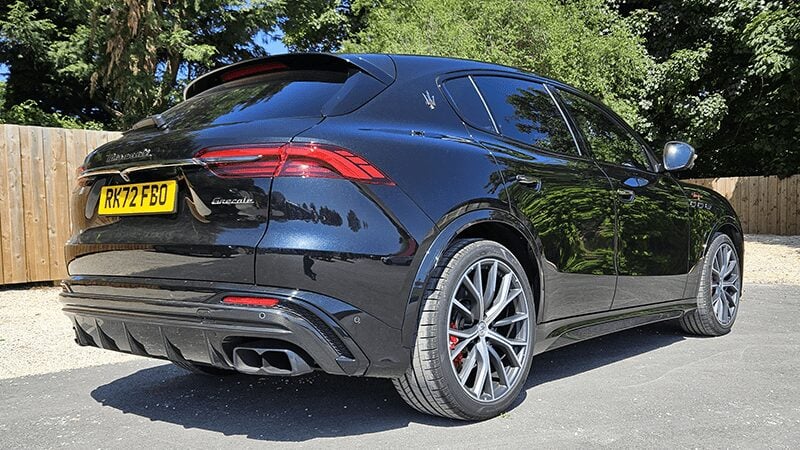
What’s it Like to Drive?
That largely depends on what driving mode you’ve got selected… and there’s a lot of them.
In Comfort it’s as you’d expect, with a reasonable ride and relatively sedate gear changes as you amble around town. For more sporty driving you’ll want the GT Mode, which is pretty similar, but the gearbox tightens up a bit and the exhaust gives the occasional bark under full throttle or eager downshifts. Sport mode turns that all up a notch, giving you crackles through the exhaust pretty much every time as well as turning the engine up to maximum and dropping the car 15mm.
Trofeo owners also get Corsa mode, which turns all the aids down (except Launch Control, which is only available in this mode) and gives you the most raw driving experience. You can also independently adjust some aspects in Sport/Corsa modes.
Generally speaking, the car good fun to drive and responsive enough in all modes, to a point. Ultimately it is a near-enough two-tonne SUV and pretty much 5’6″ at the roofline; although it’s a pretty taut drive and never feels wallowy. The steering is always a little light, even when tightened up in Sport mode, but the Grecale certainly goes where you point it and the rear-biased AWD is playful enough. It has to be said that the ride isn’t entirely serene, despite the adaptive air suspension, which may be down to the 21-inch wheels; we didn’t get a chance to compare with the GT/Modena trims.
We didn’t get a chance to test the offroad mode, as the furthest off the road we went was a half-mile long gravel driveway at a stately home. Assuming it’s derived from the same electronics as the Stelvio/Grand Cherokee, it’ll be decent enough for anything a Grecale owner is likely to encounter and the ride height (though bumped up 30mm in this mode) will be the limiting factor on going any further. Or just simply not wanting to go off-road.
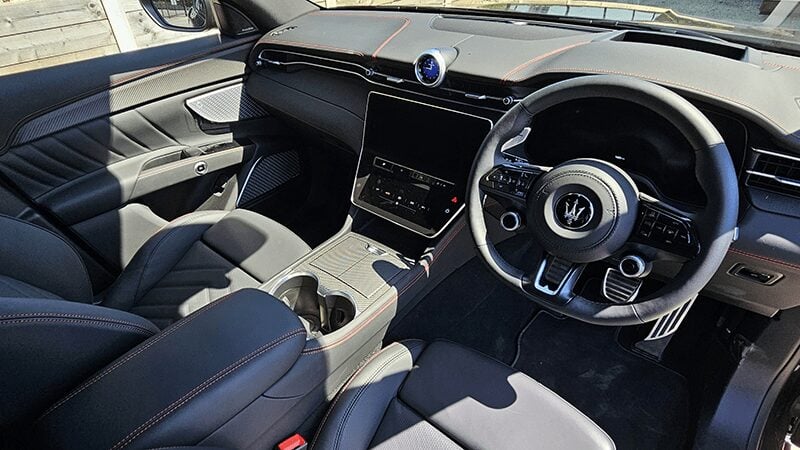
And on the Inside?
For starters, the Grecale is slightly roomier than the Stelvio, pretty much thanks to an extra 83mm in the wheelbase. That gives slightly more room for the rear passengers (we’ve been in the back of a Stelvio; it was surprisingly compact, behind a six-foot front seat passenger), and actually more luggage space – moreso in the Trofeo, with no space taken up by hybrid gubbins, at 570 litres.
You’re absolute not wanting for any kit in the cabin either. All cars have the 12.3-inch center infotainment screen and a lower, 8.8-inch “comfort” screen; the majority of vehicle controls are on these two screens, with the various climate options and personalisation settings like ambient lighting on the lower unit and all the navigation, radio/media and drive modes on the upper item. The cabin also sports the classic Maserati clock, but it’s also a TFT screen and has a variety of different settings. It’s also the core of the HMI, responding to voice commands.
Between the two main screens are four gear selector buttons which, cards on the table, we detest: pushing a black, rectangular button marked “D/M” to go is not what we’d expect on any car from a brand with sporting heritage like Maserati, even if it does free up the centre console for more storage space and cupholders.
Standard specification includes full leather, with seats including 10-way powered front items and driver’s side memory, DAB radio, dual-zone climate control, LED driving lights, powered and heated door mirrors, and power adjustable steering. Naturally the Trofeo throws just about every optional extra in on top of that, stepping it up to 14-way powered front seats, three-zone climate, a suite of safety aids and so on.
There’s still plenty of room for options, mainly around interior materials, but also some tech items such as heated outer rear seats, full LED headlights, and the like. Our car has a £2k optional, 21-speaker Sonus faber surround sound system.
All of it stands up well to a good poke and pry, and rather than reinventing the wheel, the “Maserati Intelligent Assistant” infotainment system is based on Android so shouldn’t see particularly many gremlins across its life.
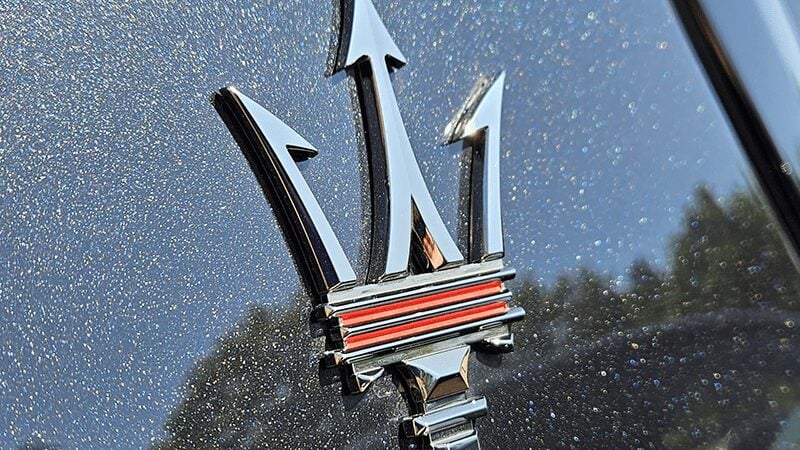
How Much Does it Cost?
Entry pricing for the Grecale range is £61,500 (or $63,500 in the USA price listings), but the Trofeo starts at more than 50% more than that at £99,700 ($105,500).
Our test car was a little more expensive, courtesy of the rather natty “Nero Tempesta” metallic paint and a couple of interior options, and would set you back around £104,000.
What are the Main Rivals?
While we’d be tempted to say the similar sibling Alfa Romeo Stelvio Quadrifoglio, it starts at £20k less and the overlap between who buys Alfa Romeos and who buys Maseratis is slimmer than you might imagine.
That said, even cars you might cross-shop with the Grecale Trofeo are coming in under – sometimes well under – the sticker price. The Porsche Macan GTS, which is admittedly a hair slower and needs a visit to the options list to get toe-to-toe, is yours for less than £80k, the Jaguar F-Pace SVR starts at £85k, and the BMW X3M is a little over £90k.

What’s the Verdict?
The Grecale in general is a pretty difficult car to dislike, unless you’re an SUVphobe. While the styling could have been a little more adventurous, it’s different enough from its siblings that even parked side-by-side you would struggle to see they’re from the same stable.
With the Nettuno engine it’s special thing to drive – even more so than the similar-engined Stelvio – and it has a solid breadth of abilities. Slightly weightier steering and some gentler manners on coarser roads (maybe even just a 20-inch wheel option) would make it even easier to recommend.
It certainly comes at a price though, and for all we like it we suspect the Macan won’t lose many customers to Modena.
See more articles on Maserati and Quick Drives.


